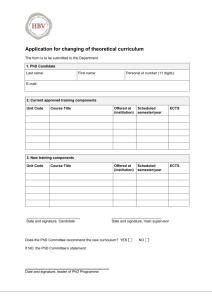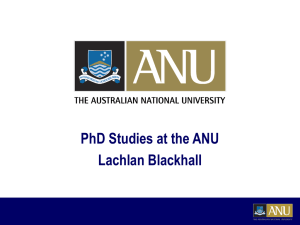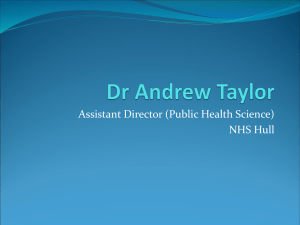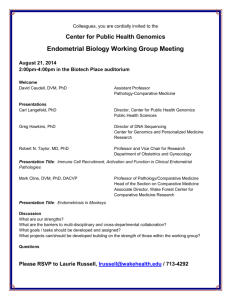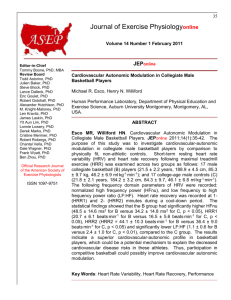Disclaimer - American Society of Exercise Physiologists
advertisement
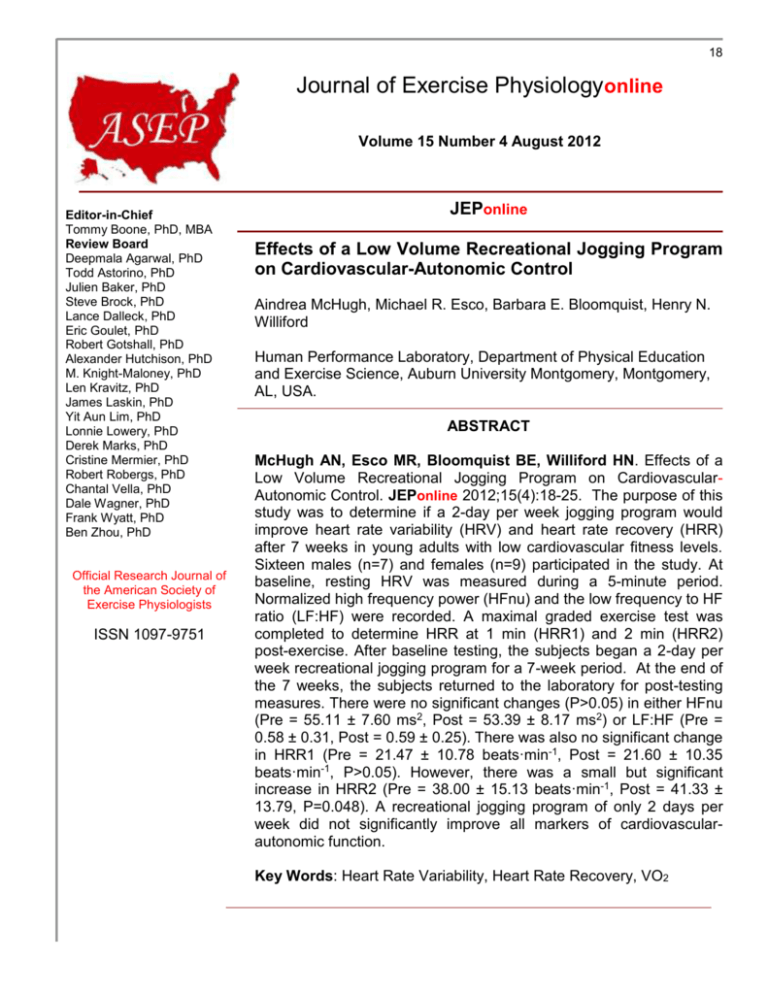
18 Journal of Exercise Physiologyonline Volume 15 Number 4 August 2012 Editor-in-Chief Tommy Boone, PhD, MBA Review Board Todd Astorino, Deepmala Agarwal, PhD PhD JulienAstorino, Todd Baker, PhD PhD Steve Brock, Julien Baker, PhD PhD Lance Brock, Steve Dalleck, PhD PhD Eric Goulet, Lance Dalleck, PhD PhD Robert Eric Goulet, Gotshall, PhD PhD Alexander Robert Gotshall, Hutchison, PhD PhD M. Knight-Maloney, Alexander Hutchison, PhD PhD LenKnight-Maloney, M. Kravitz, PhD PhD James Len Kravitz, Laskin, PhD PhD Yit AunLaskin, James Lim, PhD PhD Lonnie Yit Aun Lowery, Lim, PhD PhD Derek Marks, Lonnie Lowery, PhD PhD CristineMarks, Derek Mermier, PhDPhD Robert Robergs, Cristine Mermier,PhD PhD ChantalRobergs, Robert Vella, PhD PhD Dale Wagner, Chantal Vella, PhD PhD FrankWagner, Dale Wyatt, PhD PhD Ben Zhou, Frank Wyatt, PhD PhD Ben Zhou, PhD Official Research Journal of Official the American ResearchSociety Journalof of the Exercise American Physiologists Society of Exercise Physiologists ISSN 1097-9751 ISSN 1097-9751 JEPonline Effects of a Low Volume Recreational Jogging Program on Cardiovascular-Autonomic Control Aindrea McHugh, Michael R. Esco, Barbara E. Bloomquist, Henry N. Williford Human Performance Laboratory, Department of Physical Education and Exercise Science, Auburn University Montgomery, Montgomery, AL, USA. ABSTRACT McHugh AN, Esco MR, Bloomquist BE, Williford HN. Effects of a Low Volume Recreational Jogging Program on CardiovascularAutonomic Control. JEPonline 2012;15(4):18-25. The purpose of this study was to determine if a 2-day per week jogging program would improve heart rate variability (HRV) and heart rate recovery (HRR) after 7 weeks in young adults with low cardiovascular fitness levels. Sixteen males (n=7) and females (n=9) participated in the study. At baseline, resting HRV was measured during a 5-minute period. Normalized high frequency power (HFnu) and the low frequency to HF ratio (LF:HF) were recorded. A maximal graded exercise test was completed to determine HRR at 1 min (HRR1) and 2 min (HRR2) post-exercise. After baseline testing, the subjects began a 2-day per week recreational jogging program for a 7-week period. At the end of the 7 weeks, the subjects returned to the laboratory for post-testing measures. There were no significant changes (P>0.05) in either HFnu (Pre = 55.11 ± 7.60 ms2, Post = 53.39 ± 8.17 ms2) or LF:HF (Pre = 0.58 ± 0.31, Post = 0.59 ± 0.25). There was also no significant change in HRR1 (Pre = 21.47 ± 10.78 beats·min-1, Post = 21.60 ± 10.35 beats·min-1, P>0.05). However, there was a small but significant increase in HRR2 (Pre = 38.00 ± 15.13 beats·min-1, Post = 41.33 ± 13.79, P=0.048). A recreational jogging program of only 2 days per week did not significantly improve all markers of cardiovascularautonomic function. Key Words: Heart Rate Variability, Heart Rate Recovery, VO2 19 INTRODUCTION Cardiovascular activity is involuntarily controlled by the two branches of the autonomic nervous system. The sympathetic division is responsible for increasing heart rate (HR) while the parasympathetic, or vagal, branch is responsible for lowering HR (21). Sympatho-parasympathetic balance results in rhythmic time related changes in successive heart beats; a phenomenon known as heart rate variability (HRV). Spectral analysis of HRV has become a valid means to non-invasively evaluate cardiovascular-autonomic control during short-term recordings. In addition, the immediate return of HR toward baseline following a bout of exercise is the result of parasympathetic reactivation (2). Thus, heart rate recovery (HRR) is another simplistic method used to evaluate cardiovascular-autonomic control (2,3,6). The primary importance of HRV and HRR is due to their link to untoward, fatal events as low HRV (8) and slow HRR (3) are associated with early morbidity and mortality from cardiac and non-cardiac causes. Autonomic dysfunction at young ages is predictive of early development of cardiovascular disease. Therefore, enhanced autonomic control is suggested to be cardio-protective. Chronic exercise training appears to enhance cardiac-autonomic modulation. However, the minimum volume of exercise training required to improve HRV and HRR is unknown. Most research indicates that changes occur after the implementation of a moderate-intense training program of at least 3 days per week (4,9,10,14,17-19,24,27). There are no studies that have determined the effects of a lowfrequency (e.g., <3 days/week) aerobic-training program on HRR and HRV. Thus, the purpose of this study was to determine if a 2 day per week jogging program would improve HRV and HRR after 7 weeks in young adults with cardiovascular fitness levels below the 50th percentile compared to agematched normative data. METHODS Subjects Twenty-five apparently healthy young adults were recruited for this study. The descriptive variables (mean ± standard deviation) of all the participants at baseline are presented in Table 1. All data were collected in the Human Performance Laboratory at Auburn University at Montgomery. The research design was approved by the Institutional Review Board, and the subjects provided written informed consent. All participants completed a health-history questionnaire that was used as a screening tool to eliminate anyone with cardiovascular, pulmonary, or metabolic diseases. Table 1. Descriptive Characteristics Conditions Age (yrs) Height (cm) Pre Post 23.88 5.62 23.94 5.57 168.12 8.91 168.12 8.91 Weight (kg) 81.87 20.54 81.84 20.85 BMI (kg/m2) 28.83 6.38 28.8 6.45 BF (%) 35.48 9.62 35.43 9.87 VO2 max (mL.kg-1.min-1) 30.75 6.39 32.10 7.43 BMI, Body Mass Index; BF, Body Fat; VO2 max, Maximal Oxygen Consumption 20 Subjects were allowed to participate in the data collection process if they were not hypertensive (i.e., blood pressure <140/90 mmHg), were not participating in a competitive athletic sport, and were not taking any prescribed or over-the-counter medications. Subjects were included in data analysis if their VO2 max values were below the 50th percentile of their age and gender when compared to established normative data (1). All subjects reported to the laboratory for preliminary testing between 7:00 am and 11:00 am on any day of the week. They were instructed not to consume any caffeinated or alcoholic beverages 24 hrs before the test, to not engage in any strenuous exercise 12 hrs before, and to not eat at least 4 hrs before the test. After completing the necessary consent forms and health-history questionnaires, the subjects were briefed on the design of the study and, then, provided verbal instructions in regards to the testing protocol. PROCEDURES Baseline Measures Body Composition The following anthropometric variables were recorded: height, weight, and body mass index (BMI). Height was measured using a wall mounted stadiometer (SECA 220, Seca Ltd., Hamburg, Germany) and rounded to the nearest 0.1 cm. Weight was recorded using a digital scale (TANITA BWB-800A, Tanita Corp., Tokyo, Japan) and rounded to the nearest 0.1 kg. Body mass index (BMI) was kilograms in weight per meter of height squared. Additionally, body fat percentage (BF%) was measured via Dual Energy X-Ray Absorptiometry. Short-Term Resting Heart Rate Variability For resting HRV assessment, the subjects assumed a supine position on an athletic training table for a 10-min period before the maximal exercise test. During this time period, HR was analyzed by electrocardiography (ECG), which involved a customized lead II configuration using three Ag/AgCl electrodes (BIOPAC ES509, Goletta, CA). The electrodes were interfaced with a Biopac MP100 data acquisition system. During the 10-min supine period, the subjects were instructed to pace their breathing at 12 breaths·min-1 set by a Metronome. External stimuli and noise were removed and one of the two panels of lights within the laboratory was turned off. The ECG was sampled at a frequency of 1,000 Hz. The last 5 min of the 10-min recording was used for HRV analysis. Specialized software (Nevrokard) was used to analyze HRV in the frequency domains. Each 5-min time period was visually inspected and all abnormal beats and artifacts were removed. Any segment with three or more ectopic beats was not included in the final analysis. The 5-min ECG recordings were converted to a power spectrum by applying a Hanning window with Fast fourier transformation. The power spectrum was separated into low (LF) and high (HF) frequency powers. The HF power (0.15-0.40 Hz) and LF power (0.04-0.15 Hz) components were measured in normalized units (HFnu, LFnu), which represents the relative value of each power component in proportion to the total power minus the Very Low Frequency (VLF) component (0.0033-0.04 Hz) (26). HFnu was used in data analysis as an indicator of parasympathetic modulation. However, LFnu was recorded but not included in data analysis due to the controversies that surround this parameter (26). The LF:HF ratio was recorded and analyzed to represent the balance between sympathetic and parasympathetic modulation. Maximal Graded Exercise Test and Heart Rate Recovery A maximal graded exercise test was completed on a Trackmaster treadmill (Full Vision, Inc., Carrollton, TX) to determine maximal oxygen consumption (VO2 max). The Bruce protocol was used, which involved a series of 3-min stages with consecutive increases in speed and grade until VO 2 max was reached. Expired gas fractions were evaluated with a ParvoMedics TrueOne® 2400 metabolic 21 cart (Sandy, UT). Maximum oxygen consumption (VO2 max) was achieved if at least two of the following criteria occurred: 1) a plateau in VO2 (±2 mL·kg-1·min-1) with increasing work rate; 2) respiratory exchange ratio >1.15; 3) HR within 10 beats of age predicted maximum (220 – age); or 4) volitional fatigue. Heart rate was monitored during the test by a Polar electronic heart monitor (Polar Electro Oy, Kemple, Finland). A standard sphygmomanometer and stethoscope were used to measure blood pressure during the last 45 sec of each stage. Heart rate at VO2 max was recorded as maximal heart rate (MHR). Recovery HR was recorded during the 1st (HR1) and 2nd min (HR2) of the cool down period, during which the subjects walked at 2.5 mph at 1.5% grade. Heart rate recovery 1-min and 2-min were calculated as the difference between MHR and HR1 (HRR1) and HR2 (HRR2), respectively. Training Protocol Once the baseline testing was completed, the subjects began the 2-day per week recreational jogging program. The protocol duration was 7 weeks. Each training session began at 6:45 am CST on Tuesdays and Thursdays. During the first week, the subjects were instructed to jog 1 mile. Thereafter, weekly increases in distance of 0.25 mile were made until week 3, at which the distance increased 0.50 mile per week. If a subject could not complete the required distance during any portion of the protocol, they were encouraged to include brief bouts of walking until they were eventually able to jog the entire distance. By the end of the 7-week training period, each subject was able to complete 3 miles. It should be noted that the subjects were told to maintain and control their own pace during each jogging session. Heart rate, VO2, and ratings of perceived exertion (RPE) were not accounted for. Post Measures One week after the 7-week training program, the subjects returned to the laboratory for post-testing of the following variables: BMI, BF%, VO2 max, HRR1, HRR2, and the frequency HRV parameters. The exact testing procedures that were performed during the pre-testing were followed for post-testing. Statistical Analyses All statistics were completed using SPSS/PASW version 18.0 (IBM, Armonk, NY). Means and standard deviations were determined for the following descriptive statistics: age (yrs), height (cm), weight (kg), BMI (kg/m2), body fat (%), and VO2 max (mL·kg-1·min-1). A paired t-test was used to determine significance between the pre- and post-variables of the following: VO2 max, BF%, HFnu, LF:HF, HRR1, and HRR2. Statistical significance for all tests was set at P≤0.05. RESULTS After the pre-testing, 16 male (n=7) and female (n=9) subjects met the criteria to be included in data analysis. There were 6 subjects whose data were excluded due to either participation in a competitive sport (n=3) or VO2 max values above the 50th percentile (n=3). There were also 3 subjects whose data were excluded due to the interference of artifacts on their transformed EKG recording. The 7-week training protocol did not induce any significant changes in VO 2 max (Pre = 30.75 ± 6.39 mL·kg-1·min-1, Post = 32.10 ± 7.43 mL·kg-1·min-1, P>0.05) or BF% (Pre = 35.48 ± 9.62, Post = 35.43 ± 9.87, P>0.05). Furthermore, the HRV parameters did not change after the training program. HFnu pre and post were 55.11 ± 7.60 ms2 and 53.39 ± 8.17 ms2, (P>0.05), respectively. LF:HF pre and post were 0.58 ± 0.31 and 0.59 ± 0.25 (P>0.05), respectively. There was also no significant change in HRR1 (Pre = 21.47 ± 10.78 beats·min-1, Post = 21.60 ± 10.35 beats·min-1, P>0.05). However, there 22 was a significant increase in HRR2 (Pre = 38.00 ± 15.13 beats·min-1, Post = 41.33 ± 13.79, P=0.048, Figure 1). Heart rate values (beats.min-1) 45 * 40 35 30 HRR1 25 HRR2 20 15 10 Pre Post Figure 1. The change in HR recovery pre and post 7-week recreational jogging program (n=16). HRR1 = 1 min HR recovery; HRR2 = 2 min HR recovery. *Indicates significant difference in pre and post HRR2. Error bars not included for clarity. DISCUSSION The present study sought to determine if a 2-day per week jogging program would improve cardiacautonomic control after 7 weeks of recreational jogging in young adults with “below average” baseline cardiovascular fitness levels. We chose to analyze two parameters of autonomic activity: HRV and HRR, since each appears to be independently linked to cardiac-autonomic control (7). To date, there is limited research that analyzes the effects of a low-frequency aerobic training program on these two markers. Compared to baseline, we found very little change in cardiac-autonomic activity at the conclusion of the study. The 7-week recreational jogging program did not influence the frequency domain parameters of HRV (i.e., HFnu and LF:HF). In addition, there was no change in HRR1. There was a small, significant improvement in HRR2 of 3.33 beats·min-1 after the training program. Previous studies show enhanced cardiac-autonomic modulation following exercise training (22). Most of the research showing increased HRV and HRR following exercise training involved a protocol of three or more days per week (4,9,10,14,17-19,24,27). For example, an aerobic training program of 3 to 4 days per week increased HRV in postmenopausal women (10). Six sessions of aerobic exercise per week improved HRV after 8-weeks in middle-aged sedentary subjects (9). Sixteen weeks of supervised aerobic training of 3 days per week at 70-80% of HR reserve improved HF power in men (14). In addition, 12-weeks of an aerobic exercise training program of 3 days per week at 60-70% of maximal HR for 60 min per day improved HRR1 and HRR2 by 7.4 and 9.6 beats·min-1, respectively, in middle-aged obese men (11). 23 Cross-sectional studies suggest that differing volumes of physical activity influence autonomic measures. Women who engaged in “high” compared to “moderate” volumes of physical activity have been shown to have significantly greater HRV (8). Similarly, Sandercock et al. (23) found that those who reported themselves as being “most active” had greater HRV than their less active counterparts. Carnethon et al. (2) found that participants who reported in the highest tertile of frequent physical activity had significantly faster HRR than participants in the lowest tertile. These studies suggest that there is a dose-response relationship between chronic physical activity and cardiovascular-autonomic regulation. It appears that a training program consisting of a higher volume of exercise than the current study is needed to fully enhance cardiac-autonomic control. Two days per week of recreational jogging may result in only modest improvements in HRR2, but no change in resting HRV or HRR1 in young subjects with below average baseline cardiovascular fitness levels. The current results are most likely associated with the recreational jogging program failing to improve overall cardiovascular fitness. In other words, we did not find any changes in VO 2 max. Increases in cardiovascular fitness appear to enhance HRV and HRR (4,12,25). The guidelines for improving cardiovascular fitness set forth by the American College of Sports Medicine recommends an exercise training program consisting of 20 to 60 min of exercise at a moderate-to-vigorous intensity over 3 to 5 days per week (1). Therefore, the training program of only 2 days per week did not meet the minimal guidelines related to frequency of exercise. In addition, exercise intensity was self-monitored and not laboratory controlled. It is uncertain whether the subjects in the current study were meeting the recommended intensity ranges. Furthermore, there is evidence that describes the independent influence of body composition on autonomic control of HR. Poor HRV and HRR are associated with increased waist circumferences (13), greater sum of skinfolds (5), higher body mass index (BMI) values (16,20), and higher body fat percentages (15). Thus, our findings are also related to no changes in body composition in the subjects after the training program. CONCLUSIONS A recreational jogging program of only 2-days per week may not significantly improve all markers of cardiovascular-autonomic function in young adults with less than the average value of aerobic fitness levels. There were no changes found in resting HRV or HRR1 after training. Though HRR2 improved, the change was small. It appears that a training program of a greater frequency than the current study is required to induce an improvement in HRV or HRR. Future research is needed to determine the minimal volume needed to enhance cardiac-autonomic control. Address for correspondence: Esco MR, PhD, Department of Physical Education and Exercise Science, Auburn University at Montgomery, Montgomery, AL, USA, 36124. Phone (334) 244-3161; FAX: (334) 244-3198; mesco@aum.edu. REFERENCES 1. American College of Sports Medicine. ACSM’s Guidelines for Exercise Testing and Prescription. 8th Edition. Baltimore, MD: Lippincott Williams & Wilkins, 2010. 24 2. Carnethon MR, Jacobs DR, Sidney S, Sternfeld B, Gidding SS, Shoushtari C, Liu K. A longitudinal study of physical activity and heart rate recovery: CARDIA, 1987-1993. Med Sci Sports Exerc. 2005;37:606-612. 3. Cole CR, Blackstone EH, Pashkow FJ, Snader CE, Lauer MS. Heart-rate recovery immediatly after exercise as a predictor of mortality. N Engl J Med. 1999;341: 1351-1357. 4. Du N, Bai S, Oguri K, Kato Y, Matsumoto I, Kawase H, Matsuoka T. Heart rate recovery after exercise and neural regulation of heart rate variability in 30-40 year old female marathon runners. J Sports Sci Med. 2005;4:9-17. 5. Esco MR, Williford HN, Olson MS. Skinfold thickness is related to cardiovascular autonomic control as assessed by heart rate variability and heart rate recovery. J Strength Cond Res. 2011;25(8):2304-2310. 6. Esco MR, & Williford HN. Cardiovascular Autonomic Modulation in Collegiate Male Basketball Players. JEPonline. 2011; 14: 35-42. 7. Esco MR, Olson MS, Williford HN, Blessing DL, Shannon D, Grandjean P. The relationship between resting heart rate variability and heart rate recovery. Clin Auton Res. 2009;20:33-38. 8. Gilder M, Ramsbottom R. Measures of cardiac autonomic control in women with differing volumes of physical activity. J Sports Sci. 2008;26(7):781-786. 9. Hautala AJ, Makikallio TH, Kiviniemi A, Laukkanen RT, Nissila S, Huikuri HV, Tulppo MP. Cardiovascular autonomic function correlates with the response to aerobic training in healthy sedentary subjects. Am J Physiol Heart Circ Physiol. 2003;285:H1747-H1752. 10. Jurca R, Church TS, Morss GM, Jordan AN, Earnest CP. Eight weeks of moderate-intensity exercise training increases heart rate variability in sedentary postmenopausal women. Am Heart J. 2004;147:828.e8-e15. 11. Kim MK, Tanaka K, Kim MJ, Matsuo T, Ajisaka R. Exercise training-induced changes in heart rate recovery in obese men with metabolic syndrome. Metab Syndr Relat Disord. 2009;7:469-476. 12. Levy WC, Cerqueira MD, Harp GD, Johannessen K, Abrass IB, Schwartz RS, Stratton JR. Effect of endurance exercise training on heart rate variability at rest in healthy young and men. Am J Cardiol. 1998;82:1236-1241. 13. Lin LY, Kuo HK, Lai LP, Lin JL, Tseng CD, Hwang JJ. Inverse correlation between heart rate recovery and metabolic risks in healthy children and adolescents: Insight from the National Health and Nutrition Examination Survey 1999-2002. Diabetes Care. 2008;31:1015-1020. 14. Melanson E L, Freedson, PS. The effect of endurance training on resting heart rate variability in sedentary adult males. Eur J Appl Phys. 2001;85:442-449. 15. Millis Rm, Austin RE, hatcher MD, Bond V, Faruque MU, Goring KL, Hickey BM, DeMeersman RE. Association of body fat percentage and heart rate variability measures of sympathovagal balance. Life Sciences. 2010;86:153-157. 25 16. Molfino A, Fiorentini A, Tubani L, Matruscelli M, Fanelli R, Laviano A. Body mass index is related to autonomic nervous system activity as measured by heart rate variability. Eur J Clin Nutr. 2009;63:1263-1265. 17. Myers J, Hadley D, Oswald U, Bruner K, Kottman W, Hsu L, et al. Effects of exercise training on heart rate recovery in patients with chronic heart failure. Am Heart J. 2007;153:1056-1063 18. Myslivecek PR, Brown CA, Wolfe LA. Effects of physical conditioning on cardiac autonomic function in healthy middle-aged women. Can J Appl Physiol. 2002;27:1-18. 19. Otsuki T, Maeda S, Iemitsu M, Saito Y, Tanimura Y, Sugawara J, Ajisaka R, Miyauchi T. Postexercise Heart Rate Recovery Accelerates in Strength-Trained Athletes. Med Science Sports Exerc. 2007;39:365-370. 20. Piestrzeniewicz K, Łuczak K, Wranicz JK, Goch JH. Obesity and heart rate variability in men with myocardial infarction. Cardiol J. 2008;15:43-49. 21. Powers SK, & Howley ET. Exercise Physiology: Theory and Application to Fitness and Performance. 8th Edition. New York, NY: McGraw-Hill, 2012. 22. Sandercock GR, Bromley PD, Brodie DA. Effects of Exercise on Heart Rate Variability: Inferences from Meta-Analysis. Med Sci Sports Exerc. 2005;37:433-439. 23. Sandercock, G. R., Hardy-Shepherd, D., Nunan, D., & Brodie, D. (2008). The relationships between self-assessed habitual activity and non-invasive measures of cardiac modulation in young healthy volunteers. 26 (11). J Sports Sci. 2008;26:1171-1177. 24. Stein PK, Ehsani AA, Domitrovich PP, Kleiger RE, Rottman JN. Effect of exercise training on heart rate variability in healthy older adults. Am Heart J. 1999;138:567-576. 25. Sztajzel J, Jung M, Sievert K, Bayes De Luna A. Cardiac autonomic profile in different sports disciplines during all-day activity. J Sports Med Phys Fitness. 2008;48:495-501. 26. Task Force of the European Society of Cardiology in the North American Society of Pacing Electrophysiology. (1996). Heart Rate Variability. Circulation. 1996;93:1043-1065. 27. Tiukinhoy S, Beohar N, Hsie M. Improvement in Heart Rate Recovery after Cardiac Rehabilitation. J Cardiopulm Rehabil. 2003;23:84-87. Disclaimer The opinions expressed in JEPonline are those of the authors and are not attributable to JEPonline, the editorial staff or the ASEP organization.



